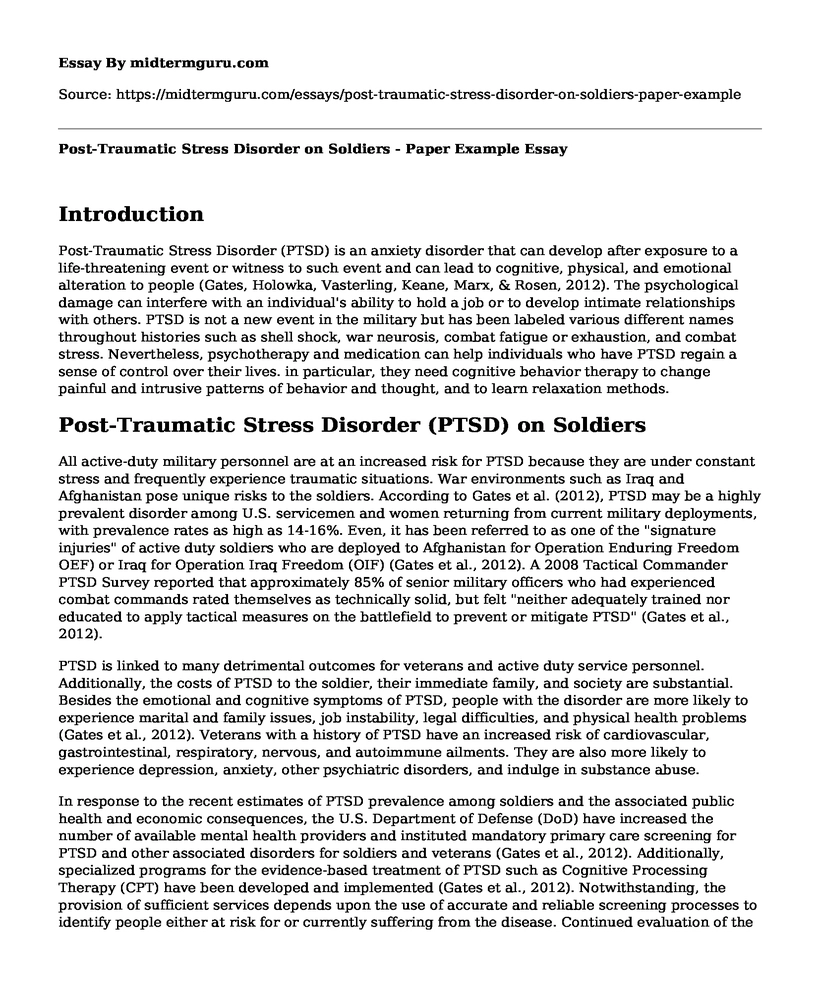Introduction
Post-Traumatic Stress Disorder (PTSD) is an anxiety disorder that can develop after exposure to a life-threatening event or witness to such event and can lead to cognitive, physical, and emotional alteration to people (Gates, Holowka, Vasterling, Keane, Marx, & Rosen, 2012). The psychological damage can interfere with an individual's ability to hold a job or to develop intimate relationships with others. PTSD is not a new event in the military but has been labeled various different names throughout histories such as shell shock, war neurosis, combat fatigue or exhaustion, and combat stress. Nevertheless, psychotherapy and medication can help individuals who have PTSD regain a sense of control over their lives. in particular, they need cognitive behavior therapy to change painful and intrusive patterns of behavior and thought, and to learn relaxation methods.
Post-Traumatic Stress Disorder (PTSD) on Soldiers
All active-duty military personnel are at an increased risk for PTSD because they are under constant stress and frequently experience traumatic situations. War environments such as Iraq and Afghanistan pose unique risks to the soldiers. According to Gates et al. (2012), PTSD may be a highly prevalent disorder among U.S. servicemen and women returning from current military deployments, with prevalence rates as high as 14-16%. Even, it has been referred to as one of the "signature injuries" of active duty soldiers who are deployed to Afghanistan for Operation Enduring Freedom OEF) or Iraq for Operation Iraq Freedom (OIF) (Gates et al., 2012). A 2008 Tactical Commander PTSD Survey reported that approximately 85% of senior military officers who had experienced combat commands rated themselves as technically solid, but felt "neither adequately trained nor educated to apply tactical measures on the battlefield to prevent or mitigate PTSD" (Gates et al., 2012).
PTSD is linked to many detrimental outcomes for veterans and active duty service personnel. Additionally, the costs of PTSD to the soldier, their immediate family, and society are substantial. Besides the emotional and cognitive symptoms of PTSD, people with the disorder are more likely to experience marital and family issues, job instability, legal difficulties, and physical health problems (Gates et al., 2012). Veterans with a history of PTSD have an increased risk of cardiovascular, gastrointestinal, respiratory, nervous, and autoimmune ailments. They are also more likely to experience depression, anxiety, other psychiatric disorders, and indulge in substance abuse.
In response to the recent estimates of PTSD prevalence among soldiers and the associated public health and economic consequences, the U.S. Department of Defense (DoD) have increased the number of available mental health providers and instituted mandatory primary care screening for PTSD and other associated disorders for soldiers and veterans (Gates et al., 2012). Additionally, specialized programs for the evidence-based treatment of PTSD such as Cognitive Processing Therapy (CPT) have been developed and implemented (Gates et al., 2012). Notwithstanding, the provision of sufficient services depends upon the use of accurate and reliable screening processes to identify people either at risk for or currently suffering from the disease. Continued evaluation of the current screening efforts is required to assess their effectiveness in identifying individuals with PTSD properly and minimizing the amount of PTSD-related suffering among veterans and active duty soldiers.
Conclusion
To conclude, PTSD is a potentially harmful mental disorder that is prevalent among active-duty soldiers and veterans. Prevalence research and large-scale screening initiatives have helped to define the scope of the problem among soldiers, while epidemiologic studies have enhanced the understanding of the etiology of the disorder and the attributes of those at highest risk. Given the exhaustive nature of the symptoms of PTSD and the seriousness of the associated medical conditions, additional studies on PTSD on soldiers should be an area of high priority.
References
Gates, M. A., Holowka, D. W., Vasterling, J. J., Keane, T. M., Marx, B. P., & Rosen, R. C. (2012). Posttraumatic stress disorder in veterans and military personnel: Epidemiology, screening, and case recognition. Psychological services, 9(4), 361.
Cite this page
Post-Traumatic Stress Disorder on Soldiers - Paper Example. (2022, Sep 21). Retrieved from https://midtermguru.com/essays/post-traumatic-stress-disorder-on-soldiers-paper-example
If you are the original author of this essay and no longer wish to have it published on the midtermguru.com website, please click below to request its removal:
- My Own Theory of Personality - Essay Sample
- Misdiagnosis in Mental Health - Essay Example
- Paper Example on Personality and Individual Differences
- The Coddling of the American Mind - Article Analysis Essay
- Impact of Personality on Consumer Behavior - Research Paper
- Psychology of Emotion, Motivation & Stress: Impact on Humans - Essay Sample
- Cognitive Aging: Developmental Processes Across Adulthood - Resesarch Paper







